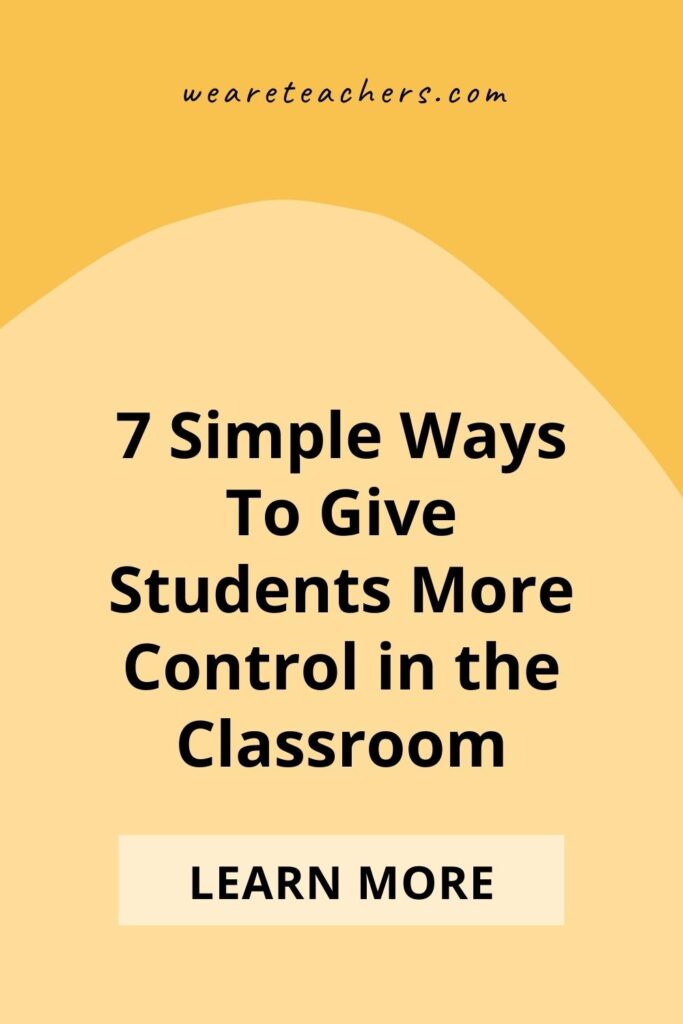The last few years have been quite a ride, to say the least. With all of the constantly changing procedures and protocols, teachers have had to really take the wheel. We had to alter many of our usual classroom practices and routines in a way that took away some of the choice and control from students. But it is important for students to have the opportunity to take control in our classrooms. Here are seven ideas—some old, some new, some tried and true—for simple ways to give students more control, while giving you the chance to focus on other parts of your agenda.
1. Student-Led Book Talks
Promoting a love of reading and finding books that our students love isn’t always easy. Book talks, which many teachers use, can be a simple way to get the word out about good books. Students want to know what their friends are reading and are more likely to take a recommendation from a peer. Try hosting daily or weekly book talks, or book buzzes, for five minutes at a time. Teachers can spotlight books that students have shared in their classroom libraries for students to check out later. The only hard part about book talks is deciding who gets the book first after it’s been recommended!
2. Table/Team Names


Many elementary classrooms arrange their students’ desks in clusters or seat their students at tables. Having students name these groups or teams can be an easy way to build classroom community. Teachers can give parameters to help facilitate the process and add to the fun. For example, you could specify that table names must include a book title and an animal. Table names in my fourth grade class this year include “Diary of a Wimpy Platypus,” “How To Be an Axolotl,” and “Math Monkeys.” Students enjoyed decorating the table signs and revealing their table names to the class.
3. Weekly Reflection Meetings

Morning meetings or class meetings are commonplace in many elementary classrooms. They are a great way to set the tone for the day. Weekly reflection meetings can be a great way to wrap up and reflect on the week that is ending and set the tone or expectations for the week to come. They are also an opportunity to hear student voices. A reflection meeting can begin with a simple T-chart where students contribute their thoughts on what went well and what they want to change or work on as a class the following week. This serves to celebrate group and individual accomplishments but also to set class goals. This is also the perfect time to discuss items from a class suggestion box.
4. Classroom Jobs
Classroom jobs are intended to give students an active role in their classroom community. However, teachers often make the decisions and assign jobs in their classroom to students who are then rotated through every job. Deciding together on what jobs are necessary to make a classroom run smoothly, as well as what each job entails, is a first step toward getting the jobs done. Once the decisions have been made about which jobs to include in a classroom, the next step is to have students apply. Applying for jobs that they actually want to do increases the likelihood that the jobs will be completed and will be done well. Job holders can report out during weekly reflection meetings, sharing how things are going and what help may be needed from classmates. When it comes time to change jobs, the previous job holder can “train” the next new hire. One way to really hand over control after things are moving along: Hire a CEO—Classroom Executive Officer—to remind students to complete their jobs and to keep track of who has had which jobs and when it is time to give current job holders some time off.
5. Classroom News Reporter

Communication between home and school is key to student success. It is important to keep families and caregivers informed of what is going on in the classroom. Teachers often spend a great deal of time each week writing newsletters. If you “hire” a student to report on what the class is learning, you not only save time, but you give the students an opportunity to write purposefully for a real audience. One way to have students report on the goings-on in the classroom is through Google Slides. Students can create a deck with a slide for each subject and include photos that they take to accompany their writing. After a week or two, the slides can be shared with the class and with families at home.
6. DIY Homework


Do-it-yourself homework can take away some of the stress associated with traditional homework. When DIY homework is first implemented, students may simply duplicate the type of homework they had been given in the past, but when they realize that they do have choices, the homework can become creative and innovative. For example, DIY measurement homework may have students measuring items around their home, building and then measuring structures with LEGO, or exploring standard versus non-standard measurements. The only requirement is that it coincides with or builds upon what is being learned in class. In the example above, a student created a work of art on a chalk wall at home and then applied math to determine the dimensions and elapsed time. Home learning can then be easily shared in a gallery walk around the room.
7. Student-Created SEL Check-Ins

Social-emotional learning has become an integral component of the day in the elementary classroom. Teachers will often use SEL check-ins to help their students become self-aware of their feelings. Check-ins can take many formats including digital forms, sticky notes with emojis, hand signals, or rating scales. You’ve probably seen these rating scales, which can be images of a person, animal, or object in various states. They can range anywhere from “How are you feeling on a scale of sheep?” to “Which Thor are you today?” and can be a fun way for students to recognize and relate to emotions. Teachers can spend a lot of time selecting or preparing SEL check-ins. Once students are familiar with how to use these scales to determine their moods/feelings, turn it over to them. They can create their own scales using images of favorite book characters, athletes, or even their own pets. To help students truly understand the range of their own emotions, as well as how to read the way others are feeling, have them create a scale with their own images. In addition to SEL, this is a fun way to spotlight how important each student is to the class.


